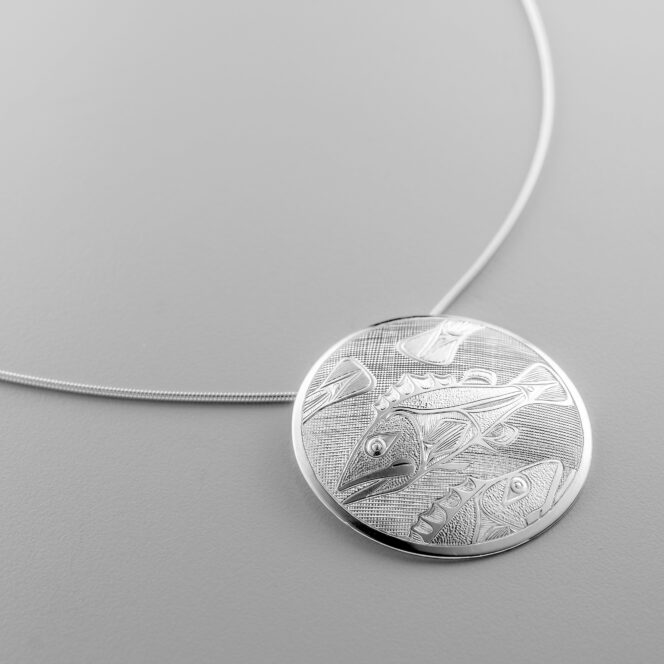
T́hax°an(Red Cod) Pendant by Lyle Wilson (Haisla Nation); Photo sourced from Coastal Peoples Fine Arts Gallery
This holiday season, you may be interested in acquiring a work by a talented local Indigenous artist to give as a gift to a loved one—or for yourself. There are so many incredible artists producing pieces that are varied, culturally rooted, and innovative. However, it’s important that any purchase is made in an informed manner to ensure artists receive the recognition and compensation they deserve.
Coastal Peoples Fine Arts Gallery, established in 1996, is located on the traditional territory of the xʷməθkʷəy̓əm (Musqueam), Sḵwx̱wú7mesh (Squamish), and səl’il’wətaʔ (Tsleil-Waututh) peoples. The Gastown gallery features a collection of First Nations and Inuit art, representative of a diverse range of mediums, including wood carvings, silver and gold jewelry, and screen prints. Artists come from the Pacific Northwest, the Plains, as well as the Northern Arctic.
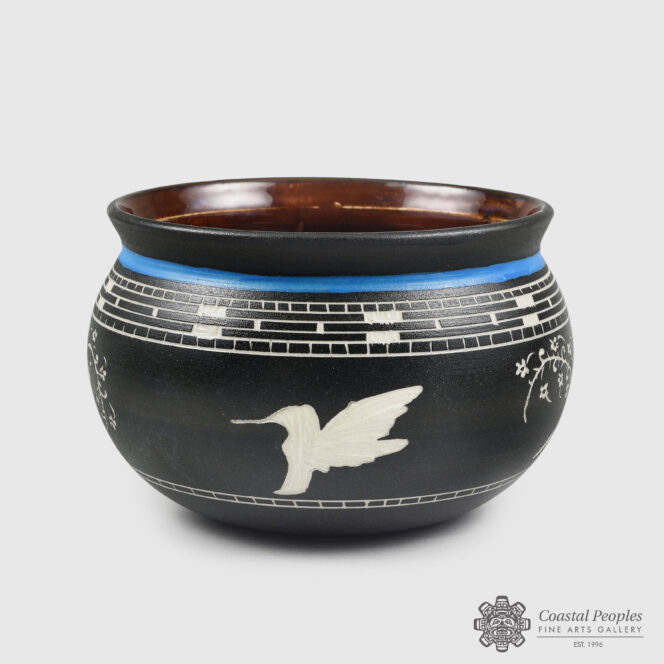
Hummingbird bowl by Patrick Leach (Interior Salish); Photo sourced from Coastal Peoples Fine Arts Gallery
Dorothy Washbern, Gallery Manager and Fine Art Consultant, emphasizes the following when purchasing Indigenous art: “Always ensure that you deal with reputable art galleries who have long-standing relationships with the individual Indigenous artists.” It’s also important that the galleries you select are knowledgeable about Indigenous art and cultures. In terms of what to look for on the artwork itself, she says that a good rule is to look for the artist’s signature on the work that you are going to use or display in your home.
Finding out as much information as possible about the piece of art, its cultural context, as well as the artist is also crucial. Coastal Peoples Fine Art Gallery does its utmost to provide artist biographies, a story about the specific art (when available), info on any crest figures on the art, information on the style of the art, and a Certificate of Authenticity and Appraisal (upon special request).
Washbern says that, for several decades Pacific Northwest galleries in B.C. have been purchasing the artwork from Indigenous artists (versus on consignment). “Since they are compensated upfront, this allows the artist to continue their work and support their families and communities,” she says. As well, artists set prices according to the value that they accord their art, thereby allowing for fair compensation.
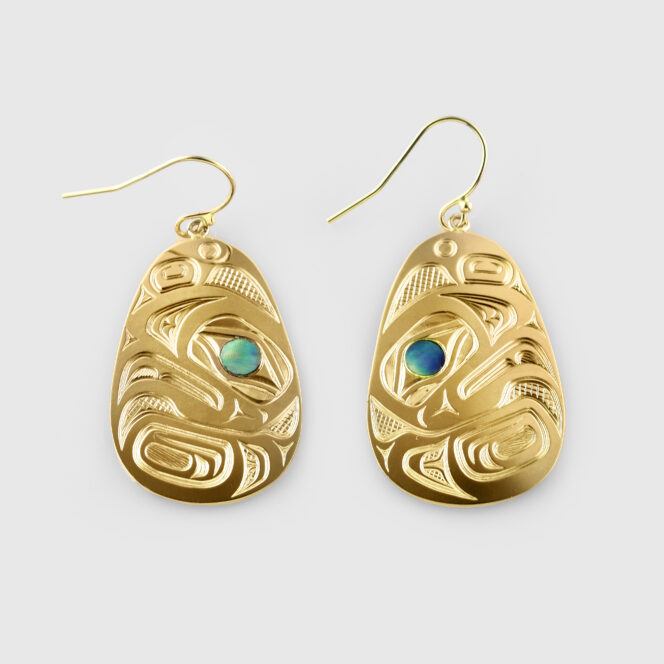
Eagle earrings by David Neel (Kwakwaka’wakw Nation); Photo sourced from Coastal Peoples Fine Arts Gallery
Beyond what the gallery provides, Washbern encourages you to do your own further reading as you consider what artists to support and what pieces of art you wish to purchase. “Research as much as you can about the individual artists as well as read recommended books on Indigenous art and culture. Attend museums and gallery exhibitions on Indigenous peoples to gain a sense of history and perspective,” she says. The Vancouver Art Gallery and the Bill Reid Gallery of Northwest Coast Art are two excellent art galleries in Vancouver that spotlight the work of Indigenous artists.
Ultimately, Washbern says purchasing art is a personal choice so it’s very much about selecting a work that “resonates with you personally” and that “you’ll love seeing every day” (or that your giftee will love). As to how to use or display the work of art, Washbern says that it’s up to you, adding how much artists appreciate people respectfully enjoying and collecting their art.
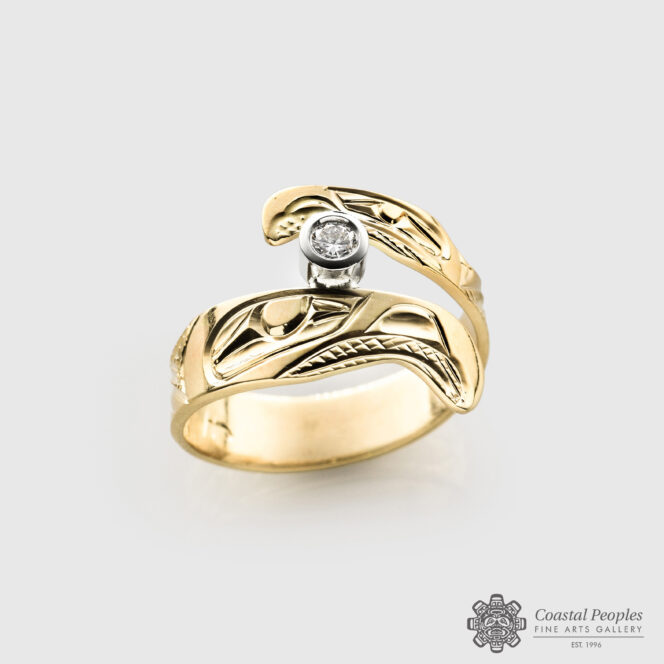
Raven wrap ring by Corinne Hunt (Kwakwaka’wakw/Tlingit Nations); Photo sourced from Coastal Peoples Fine Arts Gallery
The collection at Coastal Peoples Fine Arts Gallery is “expertly curated on a continuous basis”; that way, there’s always new pieces to discover with each visit. The Gallery also holds themed exhibitions to showcase particular artists and their works.
Washbern emphasizes the cultural specificity, diversity, and constant evolution of Indigenous art. While many artists do create using traditional styles, she says that younger, more emerging artists are producing art that is extremely innovative. “Even some of the most internationally-recognized Indigenous artists are producing amazingly modern and diversely influenced pieces as well as utilizing new media, she says.
Some examples of contemporary art that Washbern admires include Raven & UFO Panel by Don Yeomans, from the Haida and Metis Nations. The yellow cedar carved panel features an image of Raven, but in this case it features humans with a UFO, reworking the Haida legend of Raven finding the first people in a clamshell. Initiation bracelets, crafted by Gwaai Edenshaw from the Haida Nation, is part of a new Regalia line, which combines Haida tradition with contemporary fashion. And a serigraph New Horizons by famed artist Susan Point from the Musqueam Nation features bold abstract geometric shapes.
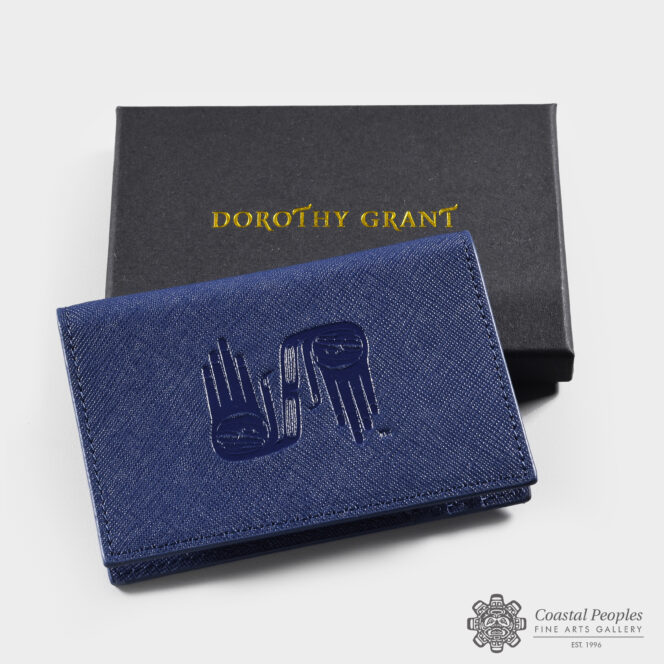
Slim wallet by Dorothy Grant (Haida Nation); Photo sourced from Coastal Peoples Fine Arts Gallery
This holiday season, Coastal Peoples Fine Arts Gallery is celebrating artists such as Robert Davidson (Haida), who is currently the subject of an exhibition entitled Guud san glans Robert Davidson: A Line That Bends But Does Not Break (running until April 16, 2023) at the Vancouver Art Gallery. Jewelry by Corrine Hunt (Kwakwaka’wakw/Tlingit), David Neel (Kwakwaka’wakw), and Lyle Wilson (Haisla) is always popular as gifts. And finally, Washbern suggests accessories, such as a raven card holder, by Dorothy Grant (Haida), or pottery, such as a basket weave bowl, by artist Patrick Leach (Interior Salish).















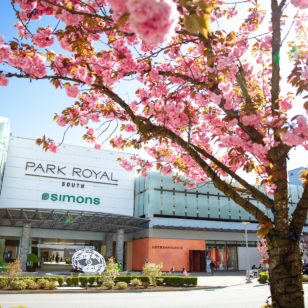
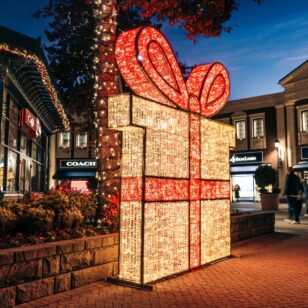
2 Responses to Guide to Buying Indigenous Art in Vancouver This Holiday Season